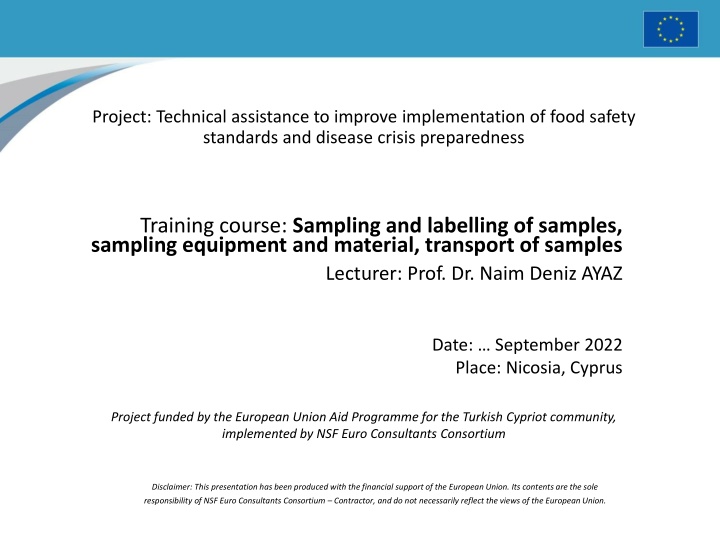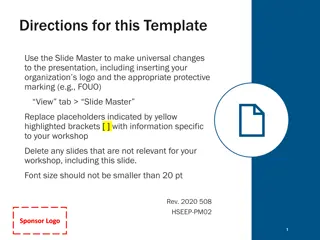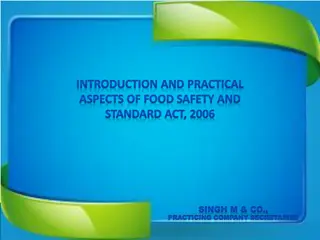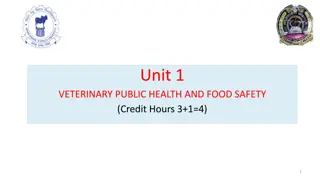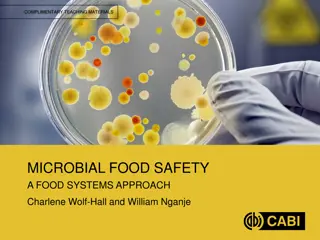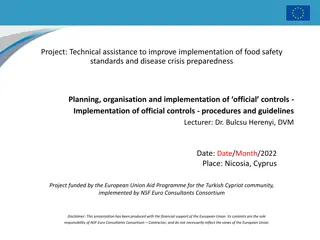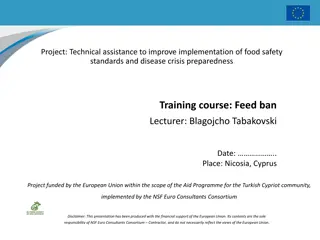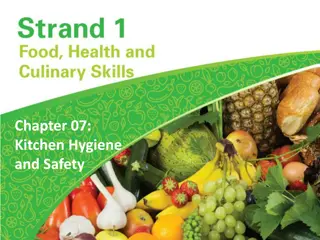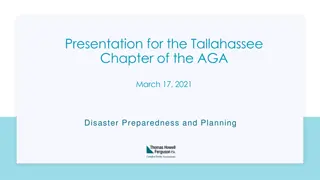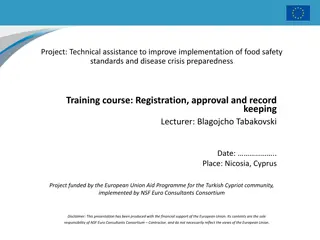Enhancing Food Safety Standards and Crisis Preparedness
This project focuses on improving the implementation of food safety standards and enhancing disease crisis preparedness through a training course on sampling, labeling, and transportation of samples. The course, conducted by Prof. Dr. Naim Deniz AYAZ, covers relevant regulations and internationally recognized standards for sampling, emphasizing the importance of proper sampling strategies. Funded by the European Union, this initiative aims to strengthen food safety practices in Nicosia, Cyprus.
Download Presentation

Please find below an Image/Link to download the presentation.
The content on the website is provided AS IS for your information and personal use only. It may not be sold, licensed, or shared on other websites without obtaining consent from the author.If you encounter any issues during the download, it is possible that the publisher has removed the file from their server.
You are allowed to download the files provided on this website for personal or commercial use, subject to the condition that they are used lawfully. All files are the property of their respective owners.
The content on the website is provided AS IS for your information and personal use only. It may not be sold, licensed, or shared on other websites without obtaining consent from the author.
E N D
Presentation Transcript
Project: Technical assistance to improve implementation of food safety standards and disease crisis preparedness Training course: Sampling and labelling of samples, sampling equipment and material, transport of samples Lecturer: Prof. Dr. Naim Deniz AYAZ Date: September 2022 Place: Nicosia, Cyprus Project funded by the European Union Aid Programme for the Turkish Cypriot community, implemented by NSF Euro Consultants Consortium Disclaimer: This presentation has been produced with the financial support of the European Union. Its contents are the sole responsibility of NSF Euro Consultants Consortium Contractor, and do not necessarily reflect the views of the European Union.
CONTENT A: Sampling B: Transport of samples
A: Sampling and labelling of samples 1A. Relevant Community rules about sampling
Regulation (EC) No 2073/2005 Chapter 3. Rules for sampling and preparation of test samples 3.1 General rules for sampling and preparation of test samples In the absence of more specific rules on sampling and preparation of test samples, the relevant standards of the ISO (International Organisation for Standardisation) and the guidelines of the Codex Alimentarius shall be used as reference methods.
Internationally Internationally recognised recognised standards standards and and guide guide for sampling for sampling Codex Alimentarius: General guidelines on sampling, CAC/GL 50-2004 ISO/DIS 7218: Microbiology of food and animal feeding stuffs - General rules for microbiological examinations. ISO 17604: Microbiology of food and animal feeding stuffs - Carcass sampling for microbiological analysis. ISO 18593: Microbiology of food and animal feeding stuffs - Horizontal methods for sampling techniques from surfaces using contact plates and swabs. NMKL (Nordic Committee on Food Analysis) Procedure No. 12: Guide on Sampling for Analysis of Foods. www.nmkl.org
2A. Sampling strategy It is a planned procedure for selecting samples from a population and for conducting the sampling to obtain the information needed. A key issue is determining what strategy is used to select the units of the target population to be subject to controls. Objective sampling Selective sampling Suspect sampling
Objective sampling A planned strategy based on the selection of a random sample, which is statistically representative of the population to be analyzed. This strategy provides data from which statistical inference can be implemented. This could be applied to a convenient selection of food retailers for hygiene controls Example: Sampling of fresh poultry carcasse at retail level for detection of Salmonella to determine the prevalence at a specific point of the food chain.
Selective sampling A planned strategy where the selection of the sample is from previously defined high-risk population groups. The sampling procedure can be random or not. If the sample is drawn randomly to be representative of the population analysed, the results can be applied to the whole of this population. Example: Sampling of high-risk products, for instance vacuum-packed cold-smoked fish product supporting monocytogenes during its shelf-life for detection and/or enumeration of L. monocytogenes to determine the rate of contamination and/or the level of contamination. the growth of Listeria
Suspect sampling A selection of samples, where the units are selected based on the judgement and experience regarding the population, lot, or sampling frame. The samples obtained from this procedure are not randomly extracted. Example: Sampling carried out as a part of a food-borne outbreak investigation or where an inspection indicates there may be a food safety problem or where a HACCP plan review results in concerns regarding potential food safety problems.
3A. 3A. Aim of sampling Aim of sampling Different sampling regimes may be required for each aim to verify the compliance with Regulation (EC) No 2073/2005, to verify the microbiological safety of food (no microbiological criteria) to obtain general information on the microbiological status to observe carefully one or more food businesses verifying their food safety management systems to check the compliance of individual batches to investigate suspected food-borne outbreaks, complaints etc. to identify and obtain information on new or emerging microbiological hazards, generating data for risk profiles and risk assessments.
4A. Sampling plan For any sampling plan there is probability of accepting a batch which may be unacceptable Two-class sampling plan Satisfactory Unsatisfactory, Three-class sampling plan Satisfactory Acceptable Unsatisfactory. based on one limit value m=M A three-class sampling plan is used if it is acceptable that some samples exceed the lower limit (m), as long as a risk contamination level (M) is not exceeded. In official sampling the sampling plans described in Regulation (EC) No 2073/2005 should be used, as a minimum, when the acceptability of a food batch or a process is assessed.
Example Example for for two two class sampling plan class sampling plan: : 5 sample units (n=5) are tested and no Salmonella positive sample unit is permitted (c=0) There is a: 90 % chance of accepting a batch containing 2 % Salmonella positive units. 77 % chance of accepting a batch containing 5 % Salmonella positive units. 59 % chance of accepting a batch containing 10 % Salmonella positive units. 17 % chance of accepting a batch containing 30 % Salmonella positive units. 3 % chance of accepting a batch containing 50 % Salmonella positive units.
5A. Sampling frequency Regulation (EC) No 2073/2005 sets down a fixed weekly sampling frequency for the FBOs for certain products: carcases minced meat meat preparations mechanically separated meat In other cases the FBOs have to decide the sampling frequency on a case- by-case basis taking into account the risk related to their products. Official controls no fixed sampling and testing frequency Competent authorities are planning their sampling strategy and aim of sampling according to Article 41 of Regulation (EC) No 882/2004.
B: Transport of Samples Standardized procedures for the transport of samples to the laboratory, the storage and the starting of the analysis are presented in ISO/DIS 7218: Microbiology of food and animal feeding stuffs - General rules for microbiological examinations.
ISO/DIS 7218: Microbiology of food and animal feeding stuffs - General rules for microbiological examinations does not set a maximum limit for the time of transportation of products not stable at ambient temperature. However, given the potential for change in the levels of the target organisms - sample should arrive at the laboratory within 36 hours after sampling. Microbiological analysis should be started as soon as possible after receipt at laboratory, preferably within 24 hours. It is recommended that analysis is started, as a rule, within 48 hours of taking the sample, unless the testing protocol specifically states otherwise.
Transportation of Refrigerated Products For highly perishable fresh, refrigerated products: During transport and storage freezing temperatures must be avoided. Pre-packed food should be stored at or below the storage temperature given on the label. given on the label. In case of examination at a later stage, e.g. for checking compliance of a prepacked food at the use by date the samples should be stored at the laboratory under the recommended conditions given on the label.
CONTACT Project e-mail: foodsafetyprojectTCc@gmail.com THANK YOU FOR YOUR ATTENTION Project funded by the European Union Aid Programme for the Turkish Cypriot community, implemented by NSF Euro Consultants Consortium
